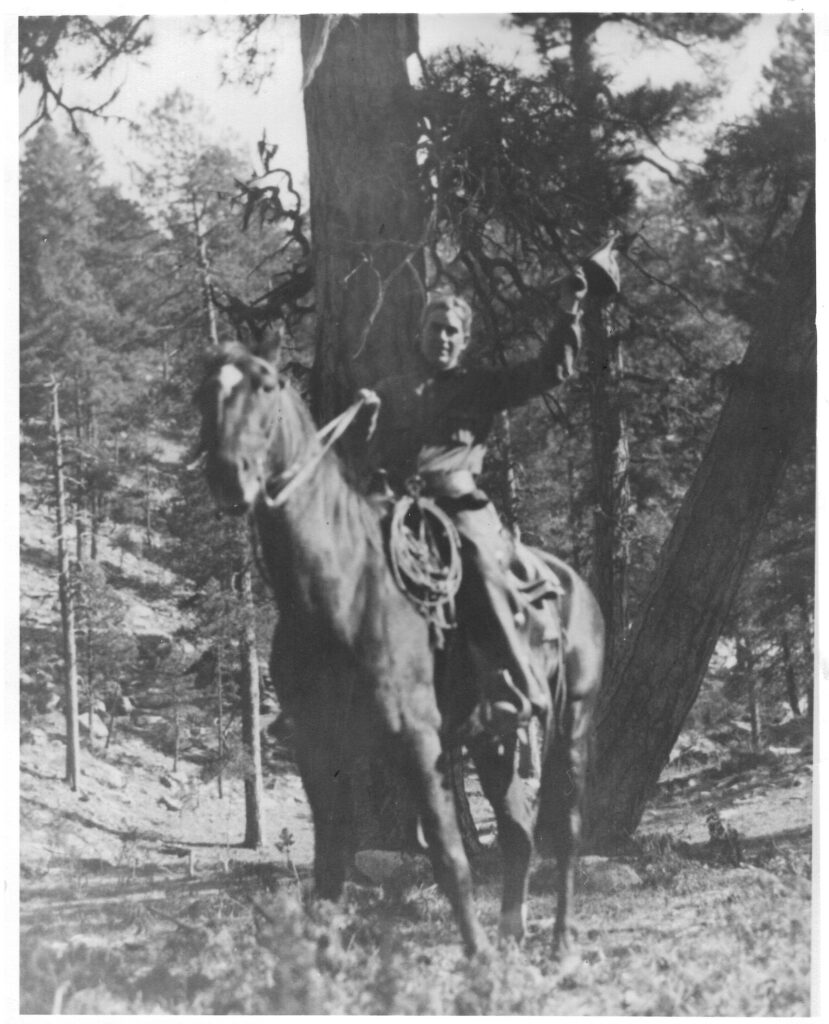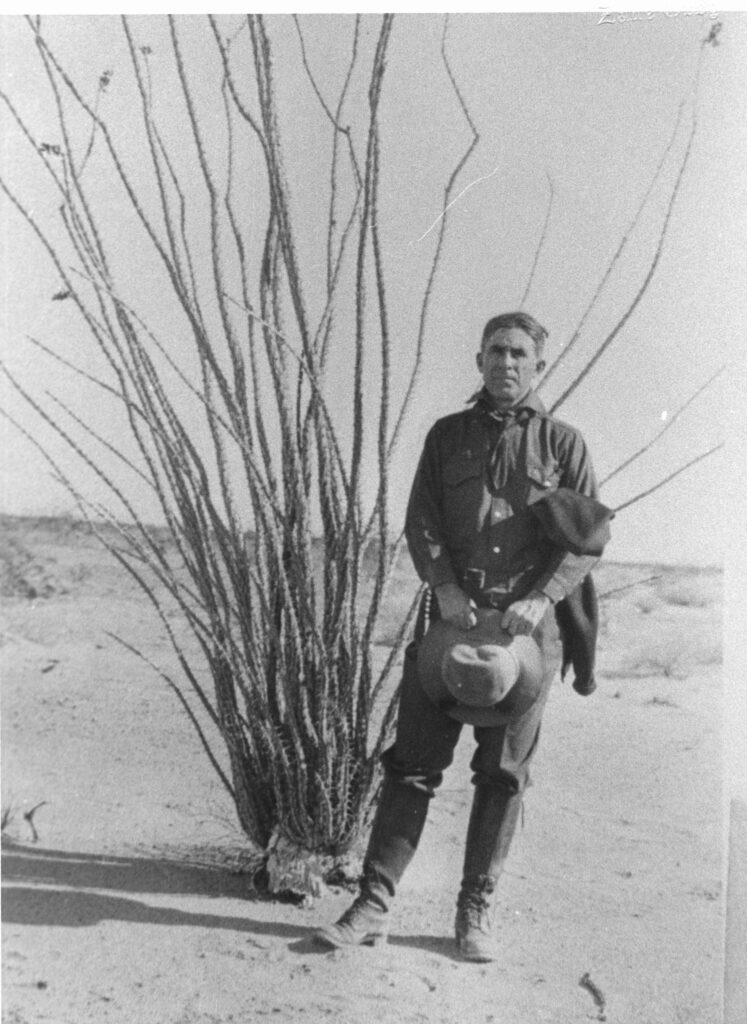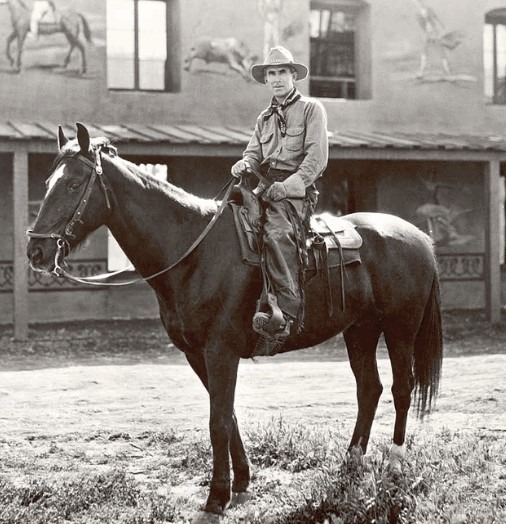Zane Grey, the Western writer, shaped the way the world will forever perceive the “Old West.” Zane Grey’s name on theater marquees was a bigger draw than the top Hollywood stars of his day. In 57 novels, 10 books of Western nonfiction, and 130 movies, Grey, who died in 1939 at age 67, almost single-handedly created the “Myth of the West.” His respectful treatment of Indians was ahead of its time; his word paintings of some of the worlds most spectacular country may never be equaled.
Grey celebrated the natural beauty of the West and the character and frontier values of its people – the so-called Code of the West. Senior Fellow Joe Wheeler wrote his doctoral thesis on Zane Grey at Vanderbilt University in 1975, and in 1983 he founded the Zane Grey’s West Society. Each June the 300-member Society hosts a convention of scholars and others whose aim is to keep alive the West as Grey saw it. In the following essay, Wheeler examines the Code of the old West – and its influence in the today’s New West.
Strangely enough, it was in a New York hotel that I finally understood what Zane Grey was trying to tell us. As the new director of a concert stage series in Texas, I was attending a convention, hoping to learn about the business of booking the high and the mighty.
The subject was contracts, and the forum was conducted by a panel of attorneys. As time passed, the subject grew murkier and I stood up to ask a question. “I have contracts in my office at home that are 10, 15, 20 pages long. But for what? It seems to me it’s a simple thing: Either the talent shows up on time and performs as specified – or does not. Why 20 pages to tell me that?”
I was nearly laughed out of the room. How naive can one get, seemed to be the reaction.
Then suddenly it hit me. I’d been struggling with my final doctoral research on Zane Grey. But now I could see that this is what Grey was talking about when he agonized about his critics. Easterners often laughed at Grey and his work. Nobody, they said, was naive enough to live as Grey’s Western characters did – with such simple values.
Grey’s World
When I returned home from New York, I was determined that before I wrote another line I would find out whether the world depicted by Grey was true. I drove to Fort Worth’s Amon Carter Museum of Western Art and burrowed into their splendid library of western history. When I emerged weeks later, I had my answer: what Grey wrote of the West was, for the most part, true.
There was a Code of the West, and Ramon Adams, the Western historian, probably explained it best in his wonderful little 1969 book, The Cowman and His Code of Ethics. Adams wrote, in part:
Back in the days when the cowman with his herds made a new frontier, there was no law on the range. Lack of written law made it necessary for him to frame some of his own, thus developing a rule of behavior which became known as the “Code of the West.” These homespun laws, being merely a gentleman’s agreement to certain rules of conduct for survival, were never written into statutes, but were respected everywhere on the range.
When legislated laws did come to the frontier they failed to meet the needs and conditions on this fringe of civilization. Men did not respect them because they could not obey them and survive. Thus the West gained a reputation for being lawless though the blame for this condition should have been placed upon the white-collared law makers, not upon the so-called law breakers.
The Cowman and His Code of Ethics, by Ramon Adams
“Unwritten Code”
Though the cowman might break every law of the territory, state and federal government, he took pride in upholding his own unwritten code. His failure to abide by it did not bring formal punishment, but the man who broke it became, more or less, a social outcast. His friends ‘hazed him into the cutbacks’ and he was subject to the punishment of the very code he had broken.
Adams breaks down his Western code into a list of qualities. Here are some of them:
- Loyalty. A cowboy took pride in being loyal to his “brand.” The highest compliment a man could receive in the Old West was: “He’ll do to ride the river with.” This was a tribute from the old trail days when only the fearless dared to swim herds across treacherous rivers. If a life-threatening mishap occurred in the crossing, the help of the nearest cowboy would be the difference between life and death.
- Friendship. There was no more sacred obligation than to be there when your friend needed you.
- Hospitality. There were no motels in the Old West. Anyone who wandered in – even an enemy – was welcome at the table. The same was true for riders who joined cowboys on the range.
- Fair Play. Westerners despised duplicity or under-handedness of any kind. The Code dictated that one could not shoot an unarmed or unwarned enemy (also known as “the rattlesnake code”: always warn before you strike). All bets were off, however, if someone was being stalked.
- Liquor. Drinking on duty was grounds for instant dismissal and blacklisting.
- Generosity. Most cowboys were generous to a fault.
- Curiosity. It was dangerous to inquire into what someone was back “in the states.” On the frontier it didn’t take long to take the measure of a man.
- Kindness. Consideration for others was central to the Code. You didn’t stir up dust in the vicinity of the chuck wagon; you didn’t wake up the wrong man for herd duty.
- The Environment. The cowboy spent most of his time in the open. He would rarely smoke during rides across fire hazard country. He had no tolerance for those who would disfigure trees or rocks.
- Integrity. Honesty was an absolute. Locks on doors were unknown until nesters moved in. Your word was your bond; a handshake was more binding than a 100 page contract. When the terrible winters of 1887-89 virtually wiped out the cattle industry, ruined ranchers literally worked their way into early graves rather than go back on their word. Should a parent die before debts were paid off, the inheriting son or daughter assumed them. Bankruptcy was not an option.
- Religion. To the average cowboy, religion meant living by the Golden Rule.
In my research, I found that Grey strayed from the truth on only a few issues. “High Noon” style gun fights on Main Street were rare. Those who lived by the gun usually died young. Women were rarely abducted.
Today we have what we call “The New West,” and its margin moves on with each new day. Does a Code of the West still exist? I submit that it does.
Self reliance continues to be a Western trait. For the first time since the Civil War, the federal bureaucracy is being seriously challenged. Washington is being asked to prove why it is a more effective trustee of Western lands and their resources than the locals who live, work, and play on those lands.

Relationship with the Land
In the West I believe there remains a willingness to trust a person rather than trust fine print. In my 20-plus-year relationship with a Texas printer, a piece of legal paper has never passed between us.
Unquestionably, the Westerner’s symbiotic relationship with the land has never been lost. The value placed on the region’s traditional industries, like ranching, has never diminished, even among many urban Westerners.
Grey realized that the West was as much as state of mind as it was a historical phenomenon. Moreover, Grey’s West, which is believed in by millions of people around the world, is based on solid historical fact.
I think welfare especially rankles Westerners because of its implied insult – that men and women are incapable of earning a living on their own, or are unwilling to help those temporarily down on their luck to get back on their feet.
Westerners, armed with the initiative and referendum, have led the fight for taxing and spending limits, term limits, deregulation and the fight for tort reform.

by Dr. Joe Wheeler
Points West Chronicle, Spring-Summer 1996
The Zane Grey’s West Society would like to express its thanks and appreciation to Dr. Joe Wheeler and the Center for the New West for their gracious permission to reprint this article for this activity.
